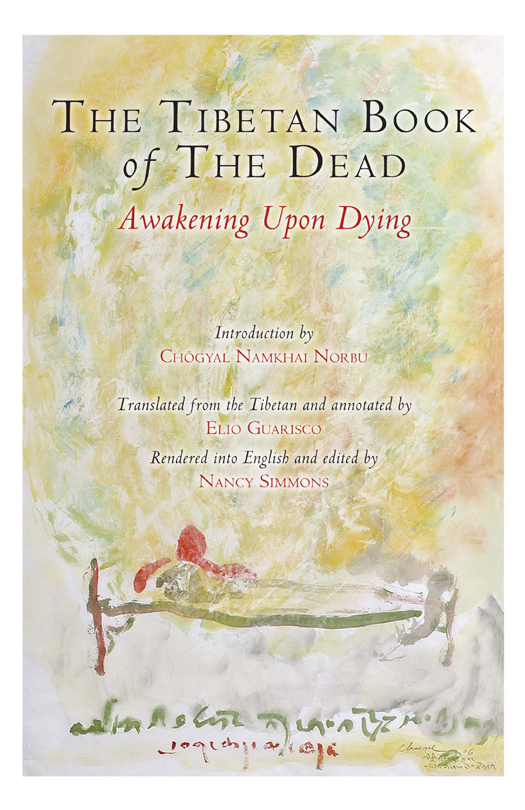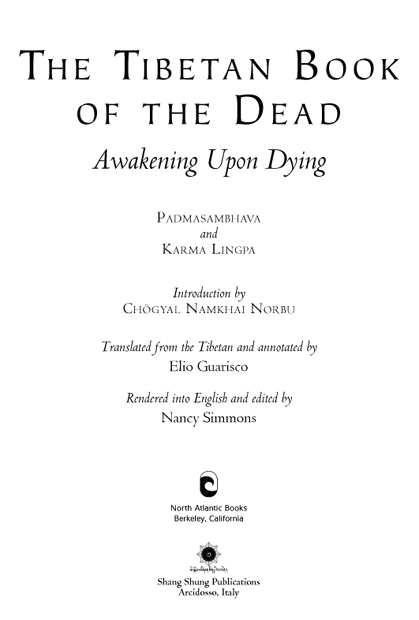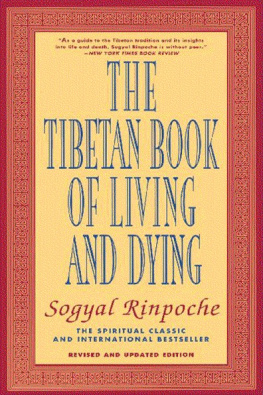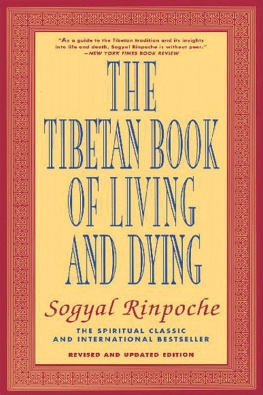Namkhai Norbu - The Tibetan book of the dead: awakening upon dying
Here you can read online Namkhai Norbu - The Tibetan book of the dead: awakening upon dying full text of the book (entire story) in english for free. Download pdf and epub, get meaning, cover and reviews about this ebook. City: Berkeley;California, year: 2013, publisher: North Atlantic Books, genre: Religion. Description of the work, (preface) as well as reviews are available. Best literature library LitArk.com created for fans of good reading and offers a wide selection of genres:
Romance novel
Science fiction
Adventure
Detective
Science
History
Home and family
Prose
Art
Politics
Computer
Non-fiction
Religion
Business
Children
Humor
Choose a favorite category and find really read worthwhile books. Enjoy immersion in the world of imagination, feel the emotions of the characters or learn something new for yourself, make an fascinating discovery.

- Book:The Tibetan book of the dead: awakening upon dying
- Author:
- Publisher:North Atlantic Books
- Genre:
- Year:2013
- City:Berkeley;California
- Rating:5 / 5
- Favourites:Add to favourites
- Your mark:
- 100
- 1
- 2
- 3
- 4
- 5
The Tibetan book of the dead: awakening upon dying: summary, description and annotation
We offer to read an annotation, description, summary or preface (depends on what the author of the book "The Tibetan book of the dead: awakening upon dying" wrote himself). If you haven't found the necessary information about the book — write in the comments, we will try to find it.
Namkhai Norbu: author's other books
Who wrote The Tibetan book of the dead: awakening upon dying? Find out the surname, the name of the author of the book and a list of all author's works by series.
The Tibetan book of the dead: awakening upon dying — read online for free the complete book (whole text) full work
Below is the text of the book, divided by pages. System saving the place of the last page read, allows you to conveniently read the book "The Tibetan book of the dead: awakening upon dying" online for free, without having to search again every time where you left off. Put a bookmark, and you can go to the page where you finished reading at any time.
Font size:
Interval:
Bookmark:

Chgyal Namkhai Norbus intention, specified in his Note to the Translation in a 1983 Italian edition, has been followed in the present volume: Rather than rendering the text from a strictly academic perspective, I have chosen an approach better suited to a Western lay public that remains, however, true to the original.
Nancy Simmons, English editor, translator, and founding member of the International Dzogchen Community established by Chgyal Namkhai Norbu
The subtitle Awakening Upon Dying epitomizes the books basic message that death is not the end, but a gate to spiritual freedom. Though The Tibetan Book of the Dead has been translated a few times in the past, this welcome new edition is supplemented by a brilliant and profound introduction by Chgyal Namkhai Norbu; traditional invocations at the time of death; and three appendices about the signs of dying, practical assistance at that time, and the symbolism of the deities appearing after death. Thus, this very practical book represents a hands-on and comprehensive guide through the whole process of dying and the afterlife.
Karl Brunnhoelzl,
author of The Center of the Sunlit Sky and The Heart Attack Sutra

Copyright 2013 by Shang Shung Publications. All rights reserved. No portion of this book, except for brief review, may be reproduced, stored in a retrieval system, or transmitted in any form or by any meanselectronic, mechanical, photocopying, recording, or otherwisewithout the written permission of the publisher. For information contact North Atlantic Books.
Published by
North Atlantic Books
P.O. Box 12327
Berkeley, California 94712
www.northatlanticbooks.com
and
Shang Shung Publications
Localit Merigar
58031 Arcidosso (GR), Italy
www.shangshungpublications.org
Cover illustration: a painting from the Bardo series, 2006, by the Venerable Eighth Dugu
Choegyal Rinpoche, courtesy of the Alessandra Bonomo Gallery, Rome; photographed by Antonello Idini
Color plate illustrations courtesy of Rubin Museum of Art; artists unknown
Cover and interior design by Daniel Zegunis
The Tibetan Book of the Dead: Awakening Upon Dying is sponsored by the Society for the Study of Native Arts and Sciences, a nonprofit educational corporation whose goals are to develop an educational and cross-cultural perspective linking various scientific, social, and artistic fields; to nurture a holistic view of arts, sciences, humanities, and healing; and to publish and distribute literature on the relationship of mind, body, and nature.
North Atlantic Books publications are available through most bookstores. For further information, visit our website at www.northatlanticbooks.com or call 800-733-3000.
Library of Congress Cataloging-in-Publication Data
Karma-glin-pa, 14th cent.
[Bar do thos grol. English]
The Tibetan book of the dead: awakening upon dying / composed by Padmasabhava; revealed by Tertn Karma Lingpa; introductory commentary by Chgyal Namkhai Norbu; translated from the Tibetan and annotated by Elio Guarisco; edited by Nancy Simmons. pages cm
Summary: This text offers a new translation of the ancient Buddhist text designed to facilitate the inner liberation of the dead or dying person at the moment of death.Provided by publisher.
Includes bibliographical references.
eISBN: 978-1-58394-573-5
1. Intermediate stateBuddhismEarly works to 1800. 2. DeathReligious aspectsBuddhismEarly works to 1800. 3. Spiritual lifeBuddhismEarly works to 1800. I. Padma Sambhava, ca. 717-ca. 762. II. Namkhai Norbu, 1938- III. Guarisco, Elio, 1954- IV. Title.
BQ4490.K3713 2013
294.3423dc23
2012032792
IPC - 73IEN12 - Approved by the International Publications Committee of the Dzogchen Community founded by Chgyal Namkhai Norbu
v3.1
Plate 1: Padmasabhava
Plate 2: One hundred peaceful and wrathful deities
Plate 3: Samantabhadra and Samantabhadr
Plate 4: Vairocana with kadhtvvar
Plate 5: Akobhya with Buddhalocan and attendant deities
Plate 6: Ratnasambhava with Mmak and attendant deities
Plate 7: Amitbha with Paravsin and attendant deities
Plate 8: Amoghasiddhi with Samayatr and attendant deities
Plate 9: Four male gatekeepers with their consorts
Plate 10: Six Buddhas
Plate 11: Five awareness holders with their consorts
Plate 12: Six herukas
Plate 13: Eight mtara
Plate 14: Eight pic
Plate 15: Four female gatekeepers
Plate 16: Twenty-eight var
Maala of Samantabhadra with mantras that liberate through hearing
Effigy of the deceased used in funeral rites
The wheel of transmigration
Avalokitevara
T HE SUBJECT OF this book is the continuity of consciousness and the consequent possibility of spiritual liberation during the process of dying and after death as understood in the Tibetan Buddhist tradition, an explanation long famed in Europe and North America as The Tibetan Book of the Dead. Contained in the present volume are two texts from a large collection of teachings pertaining to that subject known in Tibetan as the Great Liberation through Hearing. The cycle of the Great Liberation through Hearing, in turn, is itself included in a still more extensive body of literature titled the Peaceful and Wrathful Deities: The Profound Teaching on Natural Liberation through Recognition of the Primordial State. Translated from the Tibetan, these two core texts as parts of the cycle of the Great Liberation through Hearing are titled An Elucidation of the Intermediate State of Reality, Great Liberation through Hearing in the Intermediate States and An Introduction to the Intermediate State of Rebirth, Great Liberation through Hearing in the Intermediate States. They contain instructions designed to facilitate the inner liberation of the dying or dead person by helping him or her recognize and make use of the experiences that occur during three distinct phases: at the moment of death; during the bewildering and prolonged postmortem stages; and on the treacherous journey into a new existence.
This book also includes three invocations that are traditionally read to the dying person, followed by the Root Verses of the Six Intermediate States, which present the essential meaning of these six states, namely, living, dreaming, meditation, the moment of death, reality, and rebirth. Three appendixes that list signs of encroaching death, further ways to assist the dying, and the symbolism of the deities that appear in the intermediate state of reality conclude what can justly be considered a manual for spiritual realization at the moment of death and during the afterlife stages, known as the bardo or intermediate state.
These translations of the core texts, the invocations, and the root verses of the six intermediate states are a revisiting of those contained in an Italian edition titled Il Libro Tibetano dei Morti, a translation made under the supervision of professor Chgyal Namkhai Norbu by a group of his students during a Tibetan language and literature course that he taught at the LOrientale of the University of Naples in the 19791980 academic year. However, in some respects the present book can be considered a new translation of the original Tibetan texts, since Tibetan editions that have surfaced since 1980 have shed light on previously ambiguous passages, and because improvements in the interpretation of Tibetan texts in recent translations have been taken into consideration.
Font size:
Interval:
Bookmark:
Similar books «The Tibetan book of the dead: awakening upon dying»
Look at similar books to The Tibetan book of the dead: awakening upon dying. We have selected literature similar in name and meaning in the hope of providing readers with more options to find new, interesting, not yet read works.
Discussion, reviews of the book The Tibetan book of the dead: awakening upon dying and just readers' own opinions. Leave your comments, write what you think about the work, its meaning or the main characters. Specify what exactly you liked and what you didn't like, and why you think so.





